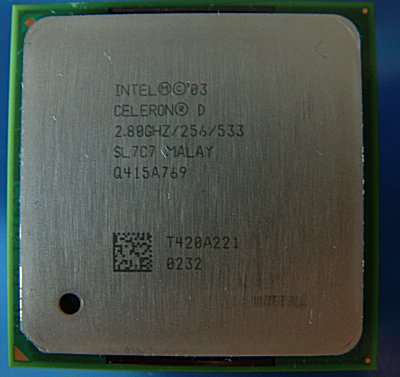Intel Celeron D 335
As mentioned, Intel's home processor hierarchy is a little easier to comprehend. The Pentium 4, available in both Socket 478 and Socket T, can be further differentiated into Northwood and Prescott cores. Northwood-class processors are only available in Socket 478 form factor and top out at 3.4GHz. Prescotts are scheduled to ramp up clock speed in Socket T form. Celerons, historically the budget line, are invariably derived from the premium CPUs, so it was no surprise to see a Prescott core-based Celeron pop up recently.

The heatspreader highlights Intel's thinking that the Celeron derivative should carry 1/4 the premium processor's L2 cache. Here's where the Celeron D scores higher than its Northwood counterpart. There are numerous other benefits that Celeron Ds carry over the equivalent Northwood Celeron, which was a reasonable budget performer in its own right. I've charachterised the differences in the following table.
| Name | Celeron 2.8GHz | Celeron D 2.8GHz |
| Derived from | Northwood core | Prescott core |
| Clock speed | 2.8GHz | 2.8GHz |
| L1 cache (data cache) | 8KB | 16KB |
| L2 cache (trace cache) | 12Kuops | 12Kuops |
| L2 cache (total) | 128KB | 256KB |
| L2 cache associativity | 2-way | 4-way |
| Bus width | 256 bits | 256 bits |
| FSB speed | 100MHz (400MHz quad-pumped) | 133MHz (533MHz quad-pumped) |
| Execution pipeline length | 20 stages | 31 stages |
| Manufacturing process | 0.13-micron | 0.09-micron |
| Memory support | DDR200/266 (up to dual-channel) | DDR333 (dual channel) |
| Bandwidth usage | 3.2GB/s | 5.4GB/s |
| Transistor count | 42-million | 55-million |
| OS support | 32-bit | 32-bit |
| Operating voltage | ~1.525v | ~1.3v |
| Form Factor | S478 | S478 |
| Hyper-Threading support | No | No |
| Instruction set | SSE2 | SSE3 |
A longer execution pipeline is a necessary evil if scalability is of primary concern. The Prescott-based Celeron D makes up for this performance shortfall by specifying greater on-chip cache levels and associativity. A faster Front-Side Bus speed also negates some of the performance penalties imposed by that 31-stage pipeline. Courtesy of the Prescott core, the Celeron D enjoys a better branch prediction setup, an improved hardware prefetch and SSE3 support. Going by the specifications listed above, the Celeron D should put up a better fight than the incumbent Northwood-based Celerons. It will need to, especially against the Sempron 3100+. It's just a shame that lush Hyper-Threading hasn't been implemented here.
Intel's also decided that pure MHz ratings aren't indicative of a processor's performance. Therefore, Celeron Ds are distinguished via a similar model numbering scheme used on Socket T Prescotts and AMDs raft of processors.
| Model name | Clock speed | Price (in retail form) |
| Celeron D 320 | 2.40GHz | £50 |
| Celeron D 325 | 2.53GHz | £55 |
| Celeron D 330 | 2.66GHz | £60 |
| Celeron D 335 | 2.80GHz | £75 |
Reasonable prices from Intel. Add in a cheap S478 board, of which there are many, and Intel's budget lineup appears to be healthy. I'll be taking a closer look at the performance of the Celeron D 335, which is matched up against AMD's Sempron 2800+ and 3100+ processors, respectively.









